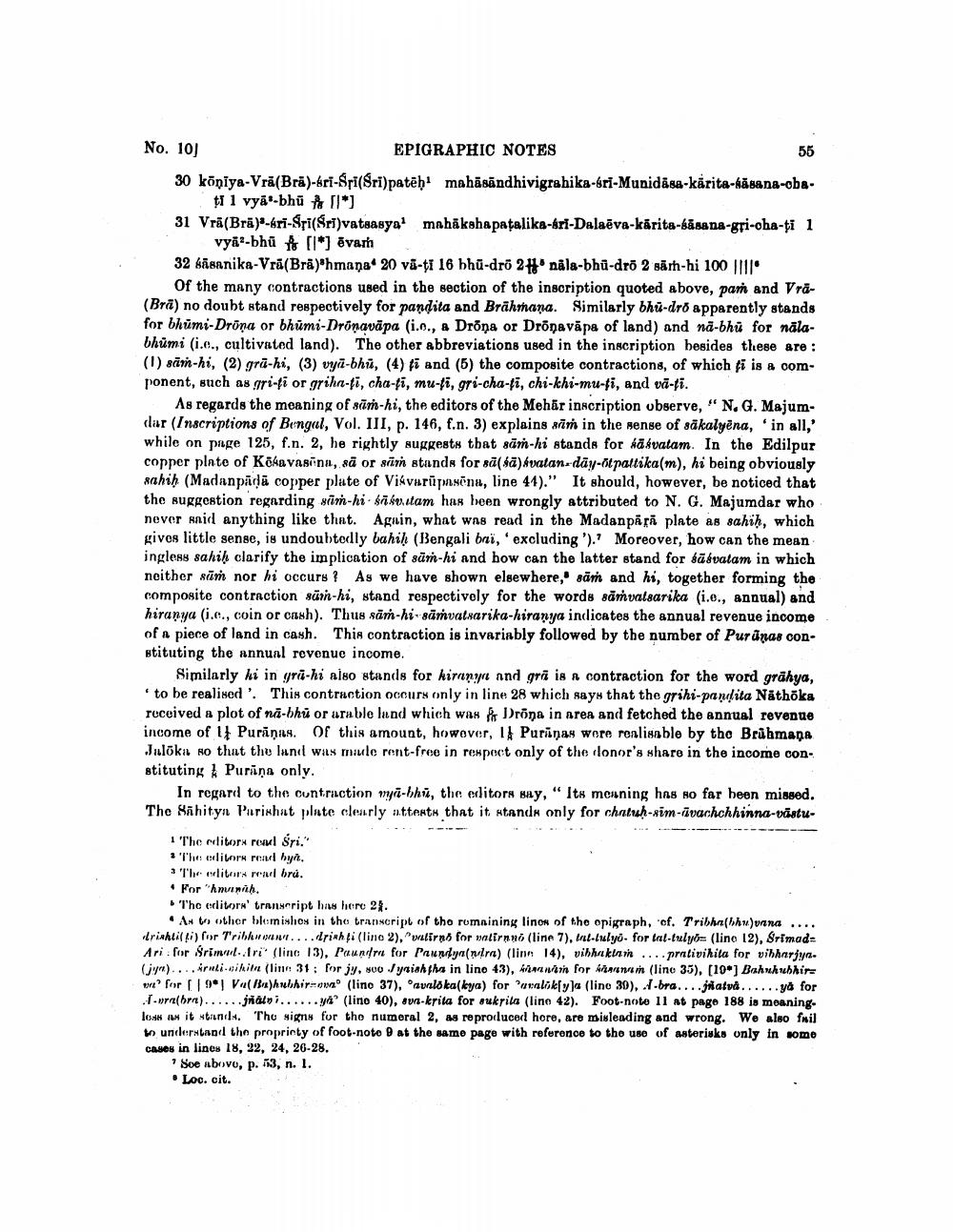________________
No. 10) EPIGRAPHIC NOTES
55 30 kõņiya-Vrā(Bra)-bri-Sri(Sri)patēhi mahāsāndhivigrabika-bri-Munidāsa-kárita-fāgana-oba
1 1 vyāt-bhū pa [l*) 31 Vrā(Bra)*-4ri-Sri(Sri)vataasya' mahākshapatalika-Sri-Dalaēva-kārita-bāsana-gri-cha-ţi 1
vya-bhū to [l*] ēvam 32 kābanika-Vrā(Brā)*hmana* 20 vã-ti 16 bhū-dro 2H nåla-bhū-dro 2 sārn-hi 100 III
Of the many contractions used in the section of the inscription quoted above, paṁ and Vra(Brā) no doubt stand respectively for pandita and Brāhmana. Similarly bhu-dro apparently stands for bhūmi-Dröna or bhūmi-Drönavāpa (1.0., a Dröna or Drönavāpa of land) and na-bhu for nālabhumi (i.c., cultivated land). The other abbreviations used in the inscription besides these are : (1) san-hi, (2) grū-hi, (3) vya-bhi, (4) fī and (6) the composite contractions, of which fi is a component, such as gri-fi or grihn-fi, cha-ti, mu-li, gri-cha-li, chi-khi-mu-li, and vā-ti.
As regards the meaning of sāí-hi, the editors of the Mehör inscription observe, "N. G. Majumdar (Inscriptions of Bengal, Vol. III, p. 146, f.n. 3) explains xim in the sense of såkalyena, 'in all,' while on page 125, f.n. 2, be rightly suggests that sām-hi stands for käsvatam. In the Edilpur copper plate of Köhavasina, sā or sim stands for 8( šā) kvatan-day-otpaltika(m), hi being obviously sahih (Madanpädā copper plate of Visvarūsēna, line 44)." It should, however, be noticed that the suggestion regarding sim-hisākottam has been wrongly attributed to N. G. Majumdar who never said anything like that. Again, what was read in the Madanpără plate as sahih, which gives little sense, is undoubtedly bahih (Bengali bni,' excluding '). Moreover, how can the mean ingless sahih clarify the implication of sür-hi and how can the latter stand for tāśvatam in which neither sāṁ nor hi occurs ? As we have shown elsewhere,' säm and hi, together forming the composite contraction sürn-hi, stand respectively for the words sārvalsarika (i.c., annual) and hiranya (i.c., coin or cash). Thus säm-hisāmvatsarika-hiranya indicates the annual revenue income of a piece of land in cash. This contraction is invariably followed by the number of Purūnas constituting the annual revenue income.
Similarly hi in gra-hi also stands for kirany and gra is a contraction for the word grähya, to be realised'. This contraction occurs only in line 28 which says that the grihi-pandita Näthöka received a plot of na-bhů or urable land which was Dröna in area and fetched the annual revenue income of Puriņus. Of this amount, however, 14 Purinay wore renlienble by the Brühmana Julõka so that the land was mule rent-free in respect only of the clonor's share in the income con. stituting & Puriņa only.
In regard to the contraction mya-bhi, the editors say, " Its meaning has so far been missed. The Māhityn Parishat plate clearly attent that it stands only for chatuh-sim-avachchhinna-vāstu
I 'The colitosk roul Sri.'
'Theelilor real hyn. * Throlitors real brú. . For "hminih.
The editors' transcript has here 24.
• An to other blemishow in the transcript of the rumnining lines of the origraph, 'cf. Tribhabhina .... trishtili) for Tribhwow....drinhli (lino 2). "wutirns for watirano (line 7), Int-tulyo. for tat-tulyón (line 12), Srimado Ari. for frimu ri (line 13), Paunrm for Paundyn (wira) (linn 14), vihhaikin .... prativihita for vibharjya. Cyn).... Aruli sihiln (linn 31 : for jy, 100 Jyrishtha in line 43), Winner for noen (line 35), [10] Bahuhubhire urt' for
Val B habhirzowa (lino 37), avaloka(kya) for 'uvalóksyla (lino 30), 1.bra....jtatva...... yd for .Turabra).....jrani......ya' (lino 40), sw-krita for sukrila (line 42). Foot-note Il at page 188 is moaning. LOAN it tand. The signs for tho numeral 2, es reproducer hore, are misleading and wrong. We also fnil in understand the proprinty of foot-noto 9 at the same page with reference to the use of asterisks only in some cases in lines 18, 22, 24, 26-28.
Soe abovo, p. 13, n. 1. • Loc. cit.




